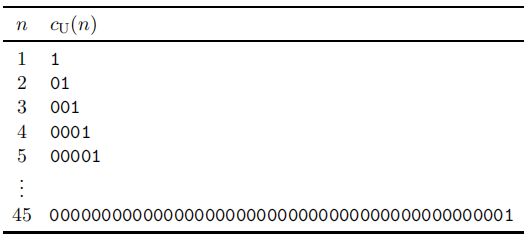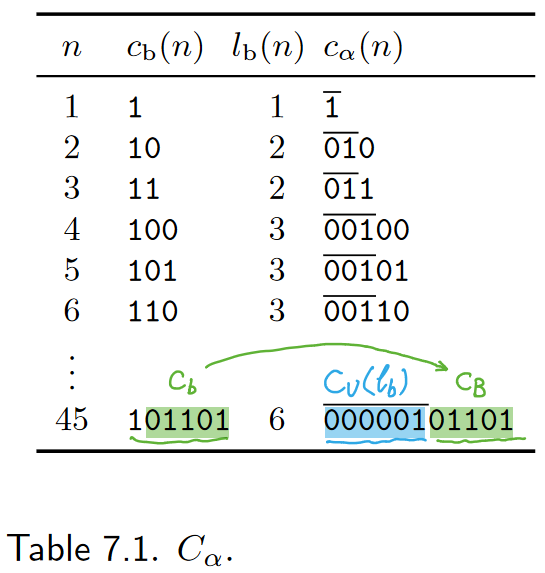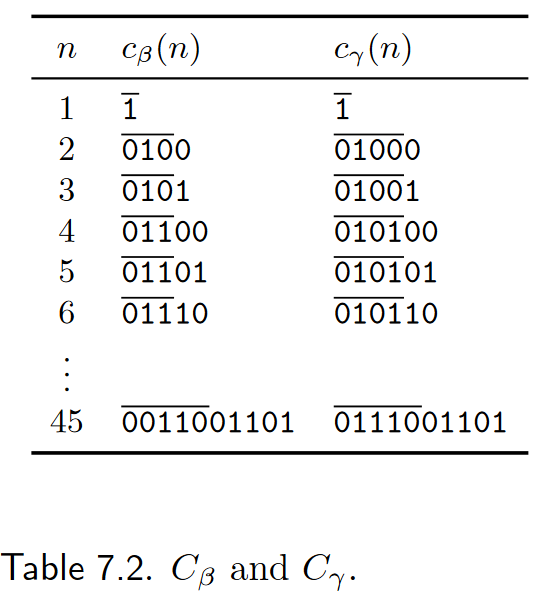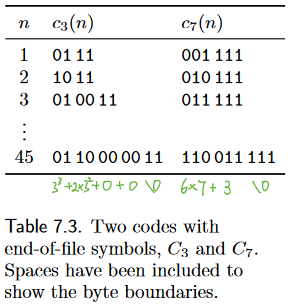整数编码
Is the standard binary representation for positive integers (e.g.
【动机】
任一(以终止符结尾)数据文件均可映射成一个(正)整数,因此若有对整数的 prefix code,则其也是对文件的 self-delimiting encoding。文件越大,其对应整数也就越大,难点在于整数范围,同文件大小一样,理论上是无穷的。
Denotation
- The standard binary representation of a positive integer:
- The standard binary length of a positive integer:
- The headless binary representation of a positive integer:
- not a uniquely decodeable code
Since there is no way of knowing when an integer has ended. For example,
How to construct uniquely decodeable code for integers
这里整数编码是指对在二进制编码基础上实现唯一可译,而非指计算机中补码,反码等对数据的存储
对正整数唯一可译编码两种方案:
- Self-delimiting codes.
传输与 - Codes with 'end of file' characters.
编码为长度为的块,并预留 个符号之一表示“结束”
Unary code
一元码,发送 n-1 个 0 和一个 1

- 码长:
- 最优时对应概率分布:
Self-delimiting codes
自定界符号码,对二进制编码长度进行编码,并生成一个自定界码
Code

- 码长:
- 最优时对应概率分布
最优概率分布近似
- 相比一元码,该码相对码长较短
Code
当 n 较大时,编码长度近似于原始长度的 2 倍,显然看起来次优有大量冗余的,可以把对长度的编码通过
- Code
- Code
- Code

Codes with end-of-file symbols
- 采用基于“字节”的表示(这里的“字节”表示任意固定长度字符串,不一定要 8bit)
- 一种高效的码如
,表示将数字编码为 15 进制数,每个数位占 4bit ( 0000—1110),并把1111作为终止符 - 类似上述思想易得基于形式
的任意进制整数码

- These codes are almost complete(满足 Kraft 不等式). 如果考虑到编码整数 0 或空字符,则为 complete
Ex 7.1
Consider the implicit probability distribution over integers corresponding to the code with an end-of-file character.
- If the code has eight-bit blocks (i.e., the integer is coded in base 255), what is the mean length in bits of the integer, under the implicit distribution?
- If one wishes to encode binary files of expected size about one hundred kilobytes using a code with an end-of-file character, what is the optimal block size?
对于 base
,因此“字节数” ,编码期望长度为 bits bits, find q such that bits, so 16-bit blocks are roughly the optimal size
Comparing the codes
- any complete code corresponds to a prior for which it is optimal; you should not say that any other code is superior to it.
- compare codes for integers is to consider a sequence of probability distributions, such as monotonic probability distributions over
, and rank the codes as to how well they encode any of these distributions - 通用码
- A code is called a 'universal' code if for any distribution in a given class, it encodes into an average length that is within some factor of the ideal average length.
- 即所构造的码对一大类先验分布中任意一个均为很好的码
- 这里所考虑的先验分布通常要求:
- 对整数分配单调递减概率
- 有限熵分布
Elias's 'universal code for integers'
| Algorithm Elias's encoder for an integer n. |
|---|
| Write '0' If Prepend |
